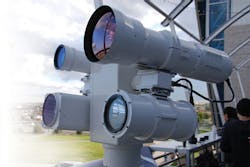UES to develop new electro-optical materials for sensors and communications
WRIGHT-PATTERSON AFB, Ohio - Electronics materials experts at UES Inc. in Dayton, Ohio, are developing new electro-optical, electronic, and magnetic materials for advanced military infrared sensors, radar, and communications.
Officials of the U.S. Air Force Research Laboratory at Wright-Patterson Air Force Base, Ohio, have announced a $42 million research contract to UES for the Nanoelectronics Materials Optimization (NEMO) program.
UES engineers will work to develop new electronic and electro-optical materials for digital, radio-frequency, microwave, infrared detector, opto-electronic, secure communications, power generation, sensing, and control applications. Of primary interest are new semiconductor materials, magnetic materials, optical and electro-optical materials, dielectric materials, and their heterostructures. UES may study lifetime and failure physics to understand these kinds of new devices and materials.
UES will design, synthesize, grow material, fabricate devices and processing methods, and evaluate new and modified materials and laboratory testing for new materials and device performance.
Air Force researchers say they believe this research could lead to:
- new solutions for frequency-agile operation over the broad electromagnetic spectrum;
- improved detection of day and nighttime events with high resolution or large coverage areas;
- sensors able to operate in high temperatures with low noise, high power density in electronic materials use;
- keeping device size, weight, and power consumption (SWaP) to a minimum; and
- affordable conformal, flexible, and shock-resistant electronic materials.
The overall goal of the NEMO program is to develop nanoscale materials and processing methodologies that are vital to create advanced materials and devices for future Air Force systems, researchers say.
UES probably won't be the only company involved; Air Force researchers say they expect to award one other contract for the NEMO program. The two contractors each will pursue the goals of two separate task orders. The first task order involves nanoscale transport electronic materials and processes, and the second task order involves quantum semiconductor and magnetic materials and processes.
Nanoscale transport electronic materials and processes will involve nanoscale electrical and thermal transport to develop improved materials and processes for high-frequency RF transistors; frequency-agile RF devices; high-bandwidth transmit/receive elements; analog-to-digital converters for electronic warfare (EW); and thermal management of electronic and electro-optic devices.
Quantum semiconductor and magnetic materials and processes, meanwhile, involves new materials based on quantum confinement of electrons and holes in nanostructured materials in III-V and II-VI semiconductors, diamond and silicon carbide nanocrystals, graphene, and multiferroic oxides.
These nanostructured materials may be superlattices, quantum dots, ultrathin films, or layered heterostructures with new electronic, magnetic, and optical properties. The goal is to discover new materials and improved processes for future electronic, magnetic, and optical devices for Air Force applications for infrared detection; tunable radar and communication devices; spintronics; and quantum encryption and information devices.
On this contract, UES will do the work at Wright-Patterson Air Force Base in Dayton, Ohio, and should be finished by September 2022.
FOR MORE INFORMATION visit UES Inc. online at www.ues.com.

